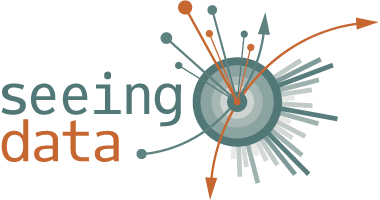The feeling of numbers (or, starting to think about our research findings)
It’s been a long time since our last project blog! Since November, we have been finalizing our field research with users, designing Phase 2 of our project website – which incorporates a large section dedicated to helping users develop their visualisation literacy – and starting to think about what we have found out on Seeing Data. During this time too, we have begun to present our research at conferences, tentatively sharing our initial analysis and inviting feedback.
So far, we’ve given these presentations:
- ‘Seeing Data: can data visualisations empower citizens?’, ECREA (European Communications Research and Education Association), Lisbon, Portugal
- ‘Seeing Data: how do people interact with data visualisations?’, MECCSA (UK Media, Communications and Cultural Studies Association), University of Northumbria, UK, January 2015
- ‘Seeing Data: how do people interact with data visualisations and why does it matter?’, Department of Sociological Studies Research Seminar Series, University of Sheffield, February 2015
- ‘Seeing Data, Feeling Numbers: how do people interact with data visualisations?’, BSA (British Sociological Association), Glasgow Caledonian University, UK, April 2015
We have also had papers accepted at the following conferences:
- ‘What can a visualisation do? Power and the visual representation of data’, Data Power, University of Sheffield, June 2015
- ‘Seeing Corpus Data’, Corpus Linguistics Conference, University of Lancaster, July 2015
- ‘Talking Mats as Visual Method’, Visual Methods, Brighton, September 2015
- ‘Seeing Data, Feeling Numbers: how people interact with data visualisations’ and ‘The role of convention in visualising and imagining data’, AOIR (Association of Internet Researchers), Phoenix, Arizona, USA, October 2015.
Through these presentations we have started to develop some ideas about:
- the factors that affect people’s engagement with visualisations,
- the skills that people need in order to engage confidently with visualisations, and
- the ways that feelings and numeracy come together each time someone engages with a visualisation.
We cover the first two things in ‘Data visualisation and you’ section of our project website (found by clicking on the Understanding Data Visualisations’ link on the left). In relation to the final point about the relationship between feelings and numbers, our research has shown us that the emotional dimensions of engaging with visualisations are vital components of making sense of data. Our participants’ engagements with visualisations involved an emotional dimension that tells us that the feeling of numbers, or how numbers feel, is important. We’re currently developing this concept of ‘the feeling of numbers’ – more on this soon!

